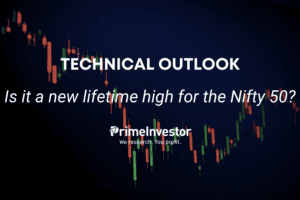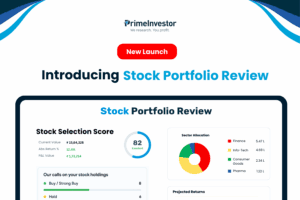
Technical outlook: Is it a new lifetime high for the Nifty 50?
How high can the Nifty 50 go?
Think Your Mutual Fund
Portfolio is Fine ?
Get a Expert Check Now
Want to learn more about the Nifty 50 index? Find out how it performed over the last 20 years, what it is made of, and much more!

How high can the Nifty 50 go?

Get a clear, actionable view of your stock portfolio with insights tailored to your holdings.

Can India be the next big thing in the evolving CRDMO market?
Price earnings ratio (PE ratio) is the rupee value that you are willing to pay for every rupee of earnings of a company. When the price of a stock is divided by the per share earnings of a company, you get the PE ratio.
What you find above is a Nifty PE Ratio Chart – which gives a complete history of this critical indicator over the last 20 years.
PE ratio is considered a key valuation metric to know how expensive a stock is in relation to its peers.
The same when applied to the Nifty 50 stocks becomes the index’ PE ratio. Since the Nifty 50 is a bellwether index, the Nifty PE is used as a gauge to know if markets are expensive or cheap.
According to the NSE website The Nifty 50 PE ratio is calculated as follows:
Formula: Index market capitalization / Gross earnings
Index market capitalization of the Index constituents is the sum total of the outstanding equity shares or units considered for index computation multiplied by the last traded price of each index constituent adjusted for factors such as free-float, capping factor etc. depending upon the index methodology; and
The earnings (including profits and losses) reported by each index constituent in trailing 4 quarters (standalone financials) are cumulated and adjusted for factors such as free-float, capping factor etc. depending upon the index methodology to arrive at the gross earnings.
In recent years, analysts in India have taken to evaluating listed companies for investment based on their consolidated rather than standalone numbers. This is because, over the past decade or so, many Indian companies have made large overseas acquisitions that now make a substantial contribution to their operations and profits. Financial services firms, which make up a significant proportion of the index, house their promising new businesses in subsidiaries too.
 But the Nifty50’s published price-earnings ratio continues to be based on the standalone earnings of its constituents rather than consolidated earnings. This didn’t matter in earlier bull markets because consolidated earnings for leading firms weren’t hugely different from standalone earnings. But it matters today when the consolidated earnings are quite different from standalone earnings.
But the Nifty50’s published price-earnings ratio continues to be based on the standalone earnings of its constituents rather than consolidated earnings. This didn’t matter in earlier bull markets because consolidated earnings for leading firms weren’t hugely different from standalone earnings. But it matters today when the consolidated earnings are quite different from standalone earnings.
When it comes to valuing companies, all sectors are not born equal. Markets assign premium valuations to sectors seen to have predictable earnings prospects and high shareholder returns such as FMCGs, IT and retail banks. Sectors with cyclical fortunes such as oil and gas, metals and mining and commodities usually trade at low PEs, even in good times.
Now, thanks to active index management, the Nifty50’s sectoral composition tends to change quite drastically over time. This makes PE comparisons over time tricky. For example, when the index is overweight on cyclicals such as oil and gas, construction or metals, the Nifty PE may seem lower than when the index is dominated by FMCG, IT or financial services (which traditionally command a premium). Hence, taking cognizance of sectoral changes in the index is important before interpreting the Nifty PE as being expensive or cheap in relation to its past PE.
When assessing a stock for investment, we don’t look at its PE in isolation but also at trends in earnings in recent years, to see if the valuation is off a low base or a high one. For a company that is just turning around from losses to profits, for instance, a high PE may be irrelevant.
The same logic applies to the index too. The PE for the Nifty50 needs to be interpreted based on whether the companies in it are coming off a period of high or low earnings growth. When the Indian market peaked out at a Nifty50 PE of over 28 times in January 2008 – the turning point of the previous bull market – Nifty companies had managed an earnings growth of 21 per cent in the preceding five years. However, for the same PE, if the earnings growth of Nifty companies is lack lustre, then may have conflicting views.
If you’re a pessimist, you can cite this as evidence that the bull market in the last five years has little basis in fundamentals. But if you’re an optimist, you can also believe that with mean reversion, the earnings are likely to rebound at some time.
For the above reasons it is good to take other fundamental metrics and valuations into consideration before any investment decisions based on the Nifty PE.
This article by Aswath Damodaran, Professor at the Stern School of Business at New York University will clearly bring out the limitations of PE as an valuation assessment metric. He also brings out the dichotomy of a higher PE ratio for cash rich companies and a lower PE ratio of debt laden companies and why this can lead to misinterpretation.
You can also read our article on whether you should dynamically alter your asset allocation based on the Nifty PE.
Hold On
You are being redirected to another page,